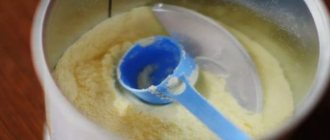11/10/201605/22/2017 Nadezhda Plotnikova
Breast milk is the optimal nutrition for a one-month-old baby and older. Together with this product, the baby can receive the most important and useful substances, as well as initial communication skills and, of course, maternal love.
However, due to certain circumstances, some mothers are unable to breastfeed, and the newborn is transferred to an alternative feeding regimen.
Artificial feeding of an infant poses many problems for the new mother: what formula to choose, how it should be prepared and given, how much the baby should eat in the first month of life.
Reasons for artificial feeding
Artificial feeding should not be introduced just like that, at the request of the nursing mother. Not a single high-quality formula is capable of transferring to a newborn baby all the necessary substances that breast milk provides.
Experts have identified several compelling reasons when adapted nutrition for newborns is necessary and even desirable.
- Labor is too difficult, after which the woman needs to restore energy and vitality.
- The mother of a one-month-old baby is taking serious medications, the instructions for which include lactation as a contraindication (often, after some time, breastfeeding can be restored).
- Infectious diseases of women that are incompatible with breastfeeding. WHO identifies only 2 true indications when a mother is unable to breastfeed her newborn: HIV and open tuberculosis. It should be understood that diseases of the heart, kidneys and other organs are not categorical indications for discontinuing breastfeeding.
- Breast milk is completely absent (agalactia) or its quantity is insufficient (hypogalactia) for the full development of children. Lack of natural nutrition can be determined by control weighing the newborn after eating. Experts claim that the absence of breast milk occurs in only 1% of lactating women due to serious hormonal imbalance.
- Breastfeeding is impossible because the mother is away from the baby for a long time. However, this condition can be considered quite reasonable unless there is nowhere to store the milk or the woman is absent for weeks or months.
First of all, you should try to restore breast milk with the help of folk remedies and medications that enhance lactation.
Adaptive nutrition of newborns is carried out only if such medications do not bring the required results.
Experts do not advise completely switching to artificial feeding if a woman has breast milk, even in minimal quantities. A few drops of a natural product will bring invaluable benefits to an infant.
Preparation
Preparing formula for a formula-fed newborn is very simple. First you need to carefully read the instructions, then rinse the bottle with nipple and rinse with boiling water.
Water for nutrition should be cooled to a temperature of 50–55 °C. The liquid is poured into a bottle with a wide neck, the recommended amount of powder is poured into it and the mixture is shaken well until the product is completely dissolved.
To check the temperature of the drink, you need to drop a little liquid on your wrist - normally the contents should not be felt. Food that is too hot can be cooled by immersing it in cold water for a couple of minutes. If the baby on IV has not finished eating, it is better to pour out the remaining liquid, although some manufacturers allow storing their product in the refrigerator.
Pros and cons of artificial feeding
Before switching to artificial feeding of newborns, every mother needs to know all the advantages and disadvantages of adapted nutrition.
Quite often, new parents switch to formula because of some far-fetched principles, thereby depriving their children of important vitamins and minerals.
The advantages of IV are as follows:
- The newborn can be fed by the father and other close relatives. The woman is freed from being next to the child every minute and is now able to go away for quite a long time, without worrying that the baby will remain hungry (it is better, of course, not to stay long).
- While breastfeeding, the mother cannot always control the amount of portion, so the baby sometimes remains hungry or, on the contrary, overeats and then burps. In addition, bottle feeding allows you to monitor deterioration in health, which is manifested by a decrease in appetite (you can see this by the volume of the remaining formula).
- If newborns who eat formula begin to have an allergic reaction, the mother always has a specific “suspect.” If breastfeeding, a woman will have to seriously reconsider her diet and give up many foods.
- Artificial nutrition takes a long time to digest (much longer than breast milk), which is why the number of meals a baby can eat can be reduced.
These are the advantages of adapted feeding, however, in the opinion of many experts, the disadvantages of artificial feeding are much more significant and serious.
- Children on IV are more likely to experience colds, infectious diseases, and allergic reactions during the first month of life and in early childhood. Doctors explain this phenomenon by the fact that the formulas lack the most important antibodies that the mother must pass on to the infant along with the milk.
- The use of feeding containers requires regular washing and even sterilization. If such conditions are not met, the newborn may develop an intestinal disorder or other dyspeptic factor.
- It is quite difficult for an infant on IV to digest a product that is not typical for his gastrointestinal tract. This is why artificial babies often suffer from colic, constant regurgitation due to swallowing air.
- When traveling long distances with a baby, the mother needs to prepare and take with her a large number of things, including the dry formula itself, clean bottles, and a suitable sterilizing device. That is, you will have to pack a whole bag and prepare food somewhere else.
- It is not always possible to immediately select the ideal formula for newborns, so new mothers are often forced to change different types of food in order to choose the most suitable one for a particular child.
- Adapted nutrition for children requires certain monetary expenditures from the mother. A balanced and complete product cannot be cheap, especially since an older infant will need a much larger amount of formula.
Thus, there are still advantages from artificial feeding, but this diet has more disadvantages. That is why it is extremely undesirable to give up breastfeeding for the sake of your own principles, the opinion of the media and the desire to feel “freedom” in the first months of a child’s life.
How to transfer a child to artificial feeding
To make the transition easier for you and your baby, it's best to transition gradually. Try to start about a month before switching completely to formula feeding. This will allow your baby to gradually adjust to bottle feeding.
Warning! Remember, when choosing infant formula, you must consult a pediatrician. In no case do you decide this yourself, much less the consultant in the store.
How to introduce the mixture
To start, skip one breastfeeding, for example, the one that is most uncomfortable for you or when you have the least amount of milk, and replace it with a bottle. As your baby adjusts to the change in diet, gradually reduce the number of breastfeedings by one.
Until you reach your desired schedule. For example, you can breastfeed your baby in the morning and before bed, and give him formula in between those feedings.
What to do if your child refuses the bottle
Try experimenting with different brands of bottles and nipples until you find one that suits your baby. You can also ask someone else (husband or relative) to feed the baby. Since your baby, feeling the smell and warmth of the mother's breast, may refuse the bottle.
Another option is to feed him when he is not too tired or hungry, then the baby will not become so nervous.
Note. If you plan to continue breastfeeding and use formula as a complementary food, you will need to wait until your baby is at least 3-4 weeks old before introducing a bottle.
Have the right attitude
For many moms, the idea of switching to formula feeding means losing the closeness they share with their baby. But this is a mistaken opinion. When you offer the bottle, you can hold your baby close in your arm, look him in the eyes, and speak or sing softly.
What rules should you follow during a sudden transition?
- For the first couple of days (2-3), give a slightly smaller amount of food than usual. Approximately 2/3 of the volume, supplementing the missing amount with warm and weak tea.
- Make sure that your baby always receives enough fluid.
- Do not keep your baby on limited feeding for a long time. If the prescribed mixture is well tolerated, its amount must be brought to normal within 3-5 days.
- When a baby switches to artificial feeding, careful monitoring by the pediatrician of the baby’s health is necessary, especially the first days of adaptation to infant formula.
Conclusion
We know for sure that the breast is best for feeding your baby. But there are many situations where “best” is simply not an option. Deciding which is better - breastfeeding or bottle-feeding a child is a personal choice for each mother.
There are many reasons why a woman might choose to breastfeed. Therefore, no one should question her decision or make her feel guilty.
For medical reasons, I also bottle-fed my daughter. Moreover, when there was not such an abundance of baby formula and such quality around. I, like many women, wanted to be an “ideal mother.” And while artificially feeding a baby doesn’t make anyone a bad mom, I still felt “guilt” every time I gave my daughter a bottle.
Now that she has grown up and, looking back, I can say for sure that it is possible to raise a child healthy even with artificial feeding. Being a mother is more than breastfeeding. What makes you a good mother is the love and attention you show to your child.
I recommend looking at what L. N. Safronova, Associate Professor of the Department of Neonatology and Neonatal Reanimation of St. Petersburg State Medical University, advises to pay attention to when artificial feeding.
What does Komarovsky say?
Pediatrician Komarovsky, who is an indisputable authority among many mothers, is convinced that breast milk is an irreplaceable product, despite the latest scientific and technical achievements.
Breast milk contains so many essential components (antibodies, hormonal substances, digestive enzymes) that its composition cannot be surpassed for a long time. Komarovsky never tires of repeating that under any circumstances, breast milk is preferable to formula.
Artificial feeding of a child is a problem that worries many young mothers who, due to various circumstances, are not able to breastfeed their newborn.
Komarovsky suggests focusing on 2 most important axioms:
- No formula, even adapted, can completely replace breast milk.
- Cow's or goat's milk is not as good a product for an infant as a balanced formula.
Komarovsky notes an interesting pattern: over the past three decades, the number of cases of food allergies or intestinal disorders in children of the first month has decreased many times (a thousand or more times), as mothers switched from animal milk to industrial formulas.
Dr. Komarovsky convinces new mothers who cannot breastfeed that feeding their babies with diluted or whole milk from a cow or goat is a huge mistake. And you shouldn’t listen to grandmothers who call mixtures a set of chemical reagents.
Komarovsky cites data that newborns under one year old should not be fed cow's or goat's milk. After 12 months and up to three years, the volume of this product should be minimal, and from preschool age the child can consume this milk in reasonable quantities.
Such restrictions are associated with the increased content of phosphorus and calcium compounds in animal milk. Such an excess of the norm of these minerals is fraught with kidney disease and pathological development of the musculoskeletal system.
Complementary feeding during artificial feeding
No matter how balanced and verified formulas for artificial feeding are, over time they become insufficient to feed a child who is growing and developing rapidly. Therefore, complementary feeding is necessary.
As with breastfeeding, so with artificial feeding, complementary foods are introduced gradually, unobtrusively, month after month. The complementary feeding scheme for artificial feeding by month is as follows:
- from the 3rd month - fruit juices and purees are introduced;
- from the 4th – vegetable puree;
- from the 5th – cottage cheese and milk porridge;
- from the 6th – yolk and meat puree;
- from the 7th – kefir and bread;
- from the 8th - fish puree.
As you can see, the first complementary feeding of a baby with artificial feeding is carried out no earlier than the 3rd month of life. Until this period, adapted milk formulas fully cover the needs of a small organism for proteins, fats, carbohydrates and minerals.
It happens that after trying the next new type of complementary food, the child refuses the previous one. For example, after trying meat puree, he turns away from cottage cheese. Or, on the contrary, having tasted sweet fruit puree, he refuses unsweetened vegetable puree as his next complementary food. In this case, you need to wait a few days for the child to forget the taste of his favorite food, and offer the necessary complementary foods again.
What mixtures are there?
So, you have weighed all the pros and cons and decided that your baby needs artificial feeding. It is important to follow certain principles and take into account certain conditions. Among them:
- choice of adapted nutrition;
- feeding mode and portion size;
- baby feeding technique.
To choose quality products for children, you need to follow the advice of an experienced doctor. Parents are offered formulas for complete feeding of healthy newborns, babies with digestive disorders, allergies and premature newborns. Let's take a closer look at them.
Adapted mixtures
These products are made from cow's milk, but the volume of protein components in it is significantly reduced by introducing demineralized whey.
For children in the first month, you need to purchase products with primary or initial formulas. On the box with the mixture this is indicated by the number 1, for example, “Nutrilak 1”.
Adapted mixtures contain a variety of essential ingredients: amino acids, including taurine (important for the visual organs and the brain), nucleotides, vitamin-mineral complexes, easily digestible carbohydrates (sucrose, for example).
By 6 months, the infant should be given products with the so-called follow-up formula. They are also called less adapted mixtures. They contain higher amounts of milk proteins and carbohydrate components to meet increased energy needs.
Fermented milk mixtures
They differ from the previous product not in quantity, but in the quality of protein elements.
Milk protein is subjected to a special enzymatic action, which means it is brought to a curdled state. As a result, the composition of the mixture approaches breast milk.
Due to this technological process, the mixture is better digested in the newborn’s gastrointestinal tract and is absorbed more quickly. Curd ingredients form optimal intestinal microflora, introducing beneficial bacteria into the body.
Such products are indicated for feeding newborns with dysbiosis, stool disorders, and a predisposition to allergies.
Also, such artificial feeding is prescribed for a weak and premature infant.
Unadapted mixtures
They are made from fresh or dried animal milk. The volume of protein components in their composition is significantly higher than in human milk.
Since the main element of such products is casein, which is unnatural for newborn babies, the development of some unsafe conditions is possible:
- disturbance of intestinal microflora;
- digestive disorders;
- low weight gain in an infant;
- delayed development.
IV experts do not recommend giving this product to an infant under 12 months of age. It does not meet the needs of babies and even threatens their well-being. Also, experts do not allow the use of cow or goat milk for cooking porridge.
Selection rules
If you cannot breastfeed your baby and it is the turn of an alternative product, it is better to coordinate the choice of formula with a specialist. The pediatrician, knowing the characteristics of the child’s body, will recommend the most gentle nutrition.
To choose the optimal product, it is necessary to take into account certain nuances and important criteria.
- Be sure to check the expiration date of the mixture. Fresh products will help avoid negative consequences. That is why you should choose packaging that has a shelf life of several months.
- Make sure the box is intact. If the packaging is deformed, dented, opened or scratched, this product is no longer suitable for feeding to an infant.
- When purchasing formula, you should consider the age of the child. So, a product recommended for babies in the seventh month of life is not suitable for a newborn. In addition, the ideal option for a one-month-old baby is hypoallergenic mixtures that are maximally adapted to the gastrointestinal tract of such a baby.
- High-quality mixtures are quite expensive. The optimal composition of the product is the result of the most serious experimental studies of entire scientific institutes. The raw materials are also quite expensive, which is why the ready-made mixture is not one of the available products. Some mothers are forced to purchase inexpensive breast milk substitutes, but experts do not recommend saving on purchasing formula, because the health of the child depends on the right choice.
- It is important to buy products from well-known brands, and this is not a tribute to advertising marketing, but to eliminate the risk of choosing low-quality dairy analogues. Well-known and reputable global manufacturers value their well-deserved reputation and will not give mothers a “pig in a poke.”
- Since the mixture does not last long, it must be used within the specified time intervals. Opened packaging should be left in dry and dark places, but it should not be placed in refrigerators, since the milk powder will simply become damp and unusable.
- If the newborn baby suffers from any health problems, formula milk may contain a variety of additives. For children with anemia, special foods fortified with iron are produced. If your baby is constantly spitting up, you should buy an anti-reflux formula.
When introducing a child to a dairy product for the first time, you need to constantly monitor his reactions and behavior: see how alert he is, monitor the color of his skin, the frequency and nature of feces.
When should you change your formula?
In the process of feeding a child with formula, signs may appear that indicate the need to select a replacement for the existing formula. These include:
- The mixture causes serious allergic reactions.
- In case of illness of the child, the mixture is replaced with a specially developed composition with medicinal properties.
- The choice of formula is influenced by the age of the newborn, so for a two-week-old baby it is strictly forbidden to use fermented milk formulas, this leads to dyspeptic disorders.
- If the baby is not gaining weight well, it is necessary to switch to highly adaptive milk formulas.
- During feeding, the baby's reaction is taken into account - if he refuses to suck from the bottle and constantly cries, then the formula must be replaced.
From the first days of life, only breast milk can completely protect a child from viral infections, due to the presence of special immunoglobulins in it. But this does not mean that the child has no immune protection at all - some immunity still managed to form in the womb.
In conclusion, I would like to note that the milk formula must be prepared strictly following the instructions indicated on the packaging. But in general, no formula, even the most adapted one, can replace breast milk. Therefore, the transition to artificial feeding should be carried out only for strict medical reasons.
How to prepare the mixture?
It should be understood that regardless of whether you are breastfeeding your baby or he is bottle-fed, you need to serve the “dish” correctly.
Before production, you should definitely study the packaging to understand how to prepare the purchased mixture. The standard requirements for the preparation of a dry milk product are as follows:
- The water for making the mixture must be of high quality. The ideal option is special baby water, at the rate of one standard container per day, in this case the water will always remain fresh. If you take such a liquid, then boiling is not necessary, since this will only worsen the quality. If the water is from a tap, borehole or well water, then it needs to be boiled.
- Follow the dosage. If you exceed the amount of dry powdery mass, the newborn’s gastrointestinal tract will be oversaturated with the nutritional mixture, and this is fraught with unstable stools, constant belching, allergic reactions, vomiting, or too rapid weight gain. If water predominates in the product, the child does not receive the required amounts of nutrients, as a result of which he remains hungry, moody, restless and does not gain weight well.
- The next step is to cool the boiled water, and its temperature should not exceed 50 °C. Higher temperatures will lead to the death of beneficial microorganisms and destruction of vitamins. Water is poured into the feeding container, then the required amount of powder is added there.
- Then you should mix the product thoroughly, making sure that no lumps form. You can check the homogeneity of the milk mixture by looking through the bottle into the light.
- If you are preparing such food for the first time, you need to know how the temperature of the product is checked. You should drop a couple of drops of milk on the bend of your elbow. The optimal temperature is 36-37 °C (that is, a person does not feel such an effect).
In some situations, you may want to cook multiple servings at once.
To prevent the mixture from disappearing, it should be placed in the refrigerator (for a day) or in a special thermos (for up to 4 hours). Of course, if you stored the product in the refrigerator, the mixture needs to be warmed up before feeding the baby. Stores sell special heaters; hot water (or tap water) is also suitable for heating. Heating in the microwave is not recommended, since the product heats up too unevenly, which means the child can get burned.
Formula dosage for newborns
Prune decoction for babies - how to prepare
Although the formulas are adapted for breast milk, they still have a slightly different ratio of proteins, carbohydrates and fats. Therefore, the calorie content of food consumed during IV is 10-15% higher. However, the single volume of liquid given to the baby increases slightly, but the daily amount remains the same as with breastfeeding.
The dosage of the formula for newborns per appointment is selected taking into account the age of the baby. Daily calorie content is calculated based on the type of mixture (i.e., carefully study the manufacturer’s information printed on the packaging).
Instructions on the package
The preparation instructions contain a table showing how to properly dilute baby powder and in what quantity for a certain age. Each child has different needs. One baby may eat more than the recommended portion, another – less. Here the mother herself selects the optimal dose for her little one.
Important! If the baby has eaten less than what was prepared for him, he should not be forced to finish the milk formula. Perhaps he ate a little more last time.
Leftover food does not need to be left until the next feeding (even if it is stored in the refrigerator). It’s better to prepare a fresh mixture the next time.
Free feeding or hourly feeding?
Experts identify two main ways to feed a bottle-fed newborn: clockwise and free-feeding.
Hourly mode
Artificial feeding must be precise. Experts often advise new mothers to follow a routine, maintaining certain intervals between feedings and following dosage standards.
How many times should newborns be fed formula? The number of meals by month looks like this:
- From 0 to 3 months. You cook and feed the child every 3 hours, at night the break is 6 hours. There are about 7 feedings per day.
- From 3 to 6 months. After 3.5 hours during the day, break for about 6 hours at night. That is, during the day, an infant will need to be fed 6 times.
- From six months. By 6 months, an artificial baby begins to be introduced to complementary feeding. At approximately the same age, complementary foods are also introduced to breastfed children. As the baby grows up, one feeding should be replaced with porridge or pureed vegetables. Now the number of meals is 5 every 4 hours, night sleep is approximately 8 hours.
Free feeding
Experts do not recommend using the free feeding method, which is somewhat reminiscent of the popular technique of breastfeeding “on demand” for an infant.
Human milk and artificial formula differ in composition. If a natural product does not lead to heaviness even with frequent breastfeeding, then diluted milk powder is not considered a “light” dish.
However, other experts suggest using partially free feeding - a method characterized by a certain feeding time. The volume of the mixture in this case depends on the child’s wishes, but is within specific limits.
You prepare and pour the mixture into a container about 25 milliliters larger, but the food should be given at a strictly fixed time. This will allow you to more accurately determine the optimal portion size needed by the child. If he leaves milk in the bottle, you should not force feed him.
Daily regime
Most mothers do not pay attention to the feeding schedule if the child is on formula. And in vain. It is when using baby food that it is necessary to strictly maintain intervals between meals. This will help avoid digestive disorders and prevent overeating.
A table that details the feeding regimen for the child by month can make it easier to create a schedule.
| Number of months | Power time |
| 1 month | Feeding at this age should be carried out 6-7 times a day according to the following scheme: — 6.30 — 9.30 — 12.30 — 15.30 — 18.30 — 21.30 and midnight This schedule is considered standard. Based on this, feeding plans for subsequent periods are drawn up. |
| 2 months | Feeding regimen for a two-month-old baby on artificial nutrition: — 6:30 — 10:30 — 13:30 — 17:00 — 21:00 - midnight |
| 3 months | At 3 months, when artificial feeding, you should adhere to the following time frame: — 6:30 — 10:30 — 14:00 — 18:00 — 21:00 and midnight |
| 4 months | The feeding regimen for a four-month-old baby will be as follows: — 6.30 — 11.00 — 15.00 — 20:00 — 22:00 |
| 5 and 6 months | At this age, the feeding schedule should be as follows: — 7:00 — 11:00 — 15:00 — 20:00 — 22:00 |
| 7 months | For a seven-month-old bottle-fed baby, the formula is given every 5 hours: — 7:30 — 12:00 — 16:30 — 21:00 According to the same schedule, the child is fed up to a year |
The given scheme for bottle-fed babies is advisory in nature. It can be changed and adjusted to the needs of a particular family. The main thing is to maintain an interval between meals.
Rules for feeding an artificial baby
Breastfeeding a baby is not so easy, let alone an artificial baby. In some situations, the child does not gain weight well, in others they talk about overfeeding. That is why mothers should follow certain rules for artificial feeding.
- An infant should be held in a “column” position (almost vertically), this position optimizes the sucking process, and the baby does not choke.
- It is important to ensure that the mixture completely fills the nipple, and the air remains only at the bottom of the feeding container. This will help prevent regurgitation. After eating, the child is not held in a “column” for a very long time to exit, in order to “drive away” possible air.
- The bottle cap should be changed regularly. Firstly, a child can damage it with his gums, and secondly, the material can become thinner, causing liquid to flow out in a stream. That is, it needs to be changed so that the baby does not choke.
- The mother feeds the one-month-old baby, holding it in her arms; an older baby can sit in a high chair. However, leaving him alone with the bottle is strictly prohibited. He may choke on the mixture or drop the container.
- During the first month, feeding containers and nozzles are sterilized after each meal. First, simply rinse the bottle with warm water, then boil the entire device. This can be done manually or in a special device - a sterilizer. From the second month, the vessel and pacifier are washed and simply doused with boiling water.
Do not think that an artificial child needs less mother's care than a natural child. It seems that his father or other relative can give him a bottle, and a pacifier can comfort him. However, experts recommend that mothers ensure the closest contact with the baby, holding him close to her and laying him side by side.
Ideally, a one-month-old baby should be fed only by the mother. You should not entrust artificial feeding to other family members. Let him suck the bottle only in his mother's arms, turning to face her. As soon as he falls asleep, the pacifier is removed from his mouth and placed in bed.
Artificial feeding of a child: advantages and disadvantages
- You do not need to sit with your child around the clock, since any of your household members will be able to feed him.
- This will allow the mother to have more peace.
- Infant formulas are easy to prepare.
- Formula takes longer to be absorbed by the baby’s body, so the time between feedings increases.
- Artificial feeding allows you to go to work if necessary. (I recommend reading the article about how a working mother can manage everything?)
- It is important for parents to know exactly how much their baby is eating at each feeding. The breast is not transparent and there are no special measurement lines to measure the amount of milk consumed, which affects the satiety of the baby. And formula feeding allows you to accurately measure this.
- The mother's medications or physical conditions no longer bother the baby who receives formula.
- You can drink and eat whatever you want! Wine, coffee, spicy foods, dairy products - everything that is impossible while breastfeeding. Since nothing you eat or drink ends up in your baby's digestive system, there's no need to worry.
- You can involve the father or relatives in feeding the child.
Disadvantages of artificial feeding
- Financial expense.
- Lack of living lymphocytes, as well as probiotics and prebiotics contained in breast milk and fighting against various infections.
- It is a fact that no formula can exactly duplicate the ideal composition of breast milk.
- When preparing a nutritional formula, you should carefully follow all the recommendations: carefully monitor the temperature so as not to give the child too hot or, conversely, cold food.
- There is a danger of any bacteria getting into the mixture.
How much formula does a newborn eat?
In a simplified diagram, the nutritional norms for an artificial diet are as follows:
- in the first 10 days, the daily volume of the formula can be calculated based on the number of days of the child’s life, multiplied by 70 or 80 (depending on body weight, 80 - if birth weight is more than 3200 g);
- from 10 days to 60 days – the child eats up to 800 milliliters of adapted nutrition 7 or 8 times;
- from 2 to 4 months – the maximum volume of milk increases to 900 milliliters (or a sixth of the child’s weight).
In order to correctly establish standards and calculate the required amount of nutrition, it is necessary to proceed from the child’s body weight. For example, a newborn weighs 4 kilograms, which means he should eat about 800 milliliters of formula per day.
When should the mixture be changed?
Feeding must correspond to the characteristics of the baby. However, not all artificial products are suitable for children, so each mixture is given at first in a small volume and not for very long, carefully monitoring any reaction.
Experts advise changing the product in the following situations:
- the child cannot tolerate the mixture, a rash, redness, regurgitation, constipation or diarrhea appears;
- the baby has reached a certain age limit when it is necessary to switch to a less adapted formula (in this case, it is recommended to change the product to a mush of the same brand);
- there is a need to switch to a special therapeutic food (an allergic reaction, for example), and then return back to the usual product.
You should proceed sequentially, observing some nuances. First, a new product is introduced, mixing it with the old one (two-thirds of the old mixture and one-third of the introduced one). Then proportionality begins to be observed, and by the end of the week the child completely switches to a previously unfamiliar product.
If a mother feeds her child with formula, her pediatrician can tell her everything about artificial feeding. Expert advice is especially valuable when choosing the first product and when replacing adaptive nutrition. Although the formula is not capable of becoming an absolute copy of breast milk, if all the basic rules are followed, the artificial baby will definitely grow up strong and healthy.
Choosing the right formula
There is a large selection of formulas on the market, and we will now tell you which formula is best for a newborn.
The mixtures depend on the age of the baby, the degree of protein breakdown, the content of nutrients and additives, the milk from which they are made and also on soy based. Specific mixtures are also available:
- anti-reflux (if the child often spits up);
- low-lactose and lactose-free (for lactose intolerance);
- gluten-free (for celiac disease);
- hypoallergenic;
- mixtures without phenylalanine (for children with the genetic disease phenylketonuria).
Based on consistency, they are divided into dry (for dilution with water) and liquid (ready to use).
By composition they are divided into:
- adapted (formulas that are as close as possible to breast milk are used for children from birth to six months);
- partially adapted (mixtures not with whey, but with casein, used from six months);
- less adapted (for infants from six months, they contain more iron).
There are fresh and fermented milk mixtures, both options can be given to a newborn. There are specific mixtures that are used to treat unhealthy children; these mixtures may contain bifidobacteria and lactobacilli, iron, soy and other special substances. There are so-called follow-up formulas that are used for older children.
How to choose formula milk for your baby? Your pediatrician should help you do this. When choosing, he will take into account:
- age;
- health features.
The mixture is administered in a microdose so that the baby’s body begins to adapt to it and produce enzymes for digestion. After the first time, you need to carefully observe whether the mixture suits the little one. If it doesn’t fit, then the baby will begin to have frequent regurgitation, diarrhea, colic, and rash.
It is also necessary to take into account that after formula the baby needs to be given water to drink, which is not possible with breastfeeding. There the child gets everything; with artificial feeding, formula does not satisfy the baby’s water needs.











